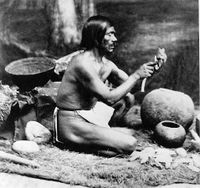Blog, Business, History, Info, Forum, Classified, Photo Album
FREE business/organization listing. Submit your promotional statement (pictures). Your business will be featured for FREE [more]
Ventura County community website created and maintained by your Ventura County neighbor |
Blog, Business, History, Info, Forum, Classified, Photo Album FREE business/organization listing. Submit your promotional statement (pictures). Your business will be featured for FREE [more] |

Rafael, a Chumash who shared cultural knowledge with Anthropologists in the 1800s
The Chumash are a Native American tribe who historically inhabit mainly the southern coastal regions of California, in the vicinity of what is now Santa Barbara and Ventura, extending as far south as Malibu. They also occupied three of the Channel Islands Santa Cruz, Santa Rosa and San Miguel, the smaller island of Anacapa was unihabited. Modern place names with Chumash origins include Malibu, Lompoc, Ojai, Point Mugu, Piru, Lake Castaic, and Simi Valley.
Population
Estimates for the pre-contact populations of most native groups in California have varied substantially. Alfred L. Kroeber thought that the 1770 population of the Chumash might have been about 10,000. Alan K. Brown concluded that the population was not over 15,000. Sherburne F. Cook at various times estimated the aboriginal Chumash as 8,000, 13,650, 20,400, and 18,500.
By 1900, their numbers had declined to just 200. According to some reports, there are now some 5,000 people who identify themselves as Chumash.
Lifestyle
The Chumash were hunter-gatherers and were adept at fishing. They are one of the relatively few New World peoples who regularly navigated the ocean (the other was the Tongva, a neighboring tribe located to the South). Some settlements built plank boats called tomols, which facilitated the distribution of goods, and could even be used for whaling. Remains of a developed Chumash culture, including rock paintings (petroglyphs) apparently depicting the Chumash cosmology, can still be seen.
ArtifactsAnthropologists eagerly sought Chumash baskets as prime examples of the craft, and two of the finest collections are at the Smithsonian Institution in Washington, DC and the Musée de l’Homme (Museum of Mankind) in Paris, France. The Museum of Natural History at Santa Barbara is believed to have the largest collection of Chumash baskets.
Possible pre-Columbian contact with PolynesiansThe maritime orientation of the Chumash has long fueled speculations about a relationship between them and the prehistoric Polynesians. The idea has recently been revived by archaeologist Terry L. Jones and linguist Kathryn A. Klar (2005, 2006; Klar and Jones 2005). They argue that the characteristics of Chumash sewn-plank canoes, curved compound fish hooks, and possible items of borrowed vocabulary all point to a trans-Pacific connection sometime between A.D. 400 and 800. Critics have countered that the traits of shared technology are not sufficiently distinctive and that the chronology of Polynesian settlement and seacraft make the hypothesis implausible (Anderson 2006).
Languages
The Chumash spoke approximately six closely related Chumashan languages which can not be connected to any other language family. For a while, it was assumed the Chumash family was part of the Hokan language phylum, but this was based solely on a few easily borrowed words, such as that for shell-bead money.
The Chumashan languages are divided into two subgroups, Northern Chumash and Southern Chumash. Northern Chumash consists solely of Obispeño, spoken around what is now San Luis Obispo, and the most divergent Chumashan language. Southern Chumash in turn consists of Central and Island Chumash. Island Chumash, sometimes called Ysleño, consisted of two dialects: Cruzeño, spoken on Santa Cruz Island, and the poorly-documented Roseño, spoken on Santa Rosa Island. Central Chumash consists of all the remaining languages, including Purisimeño, spoken around the Purisima mission, Ineseño, centered around the Santa Ynez mission, Barbareño, spoken in coastal Santa Barbara County, and Ventureño, spoken in Ventura County.
Ineseño and Barbareño were very similar, and may have been dialects; Ventureño contained several different subdialects; Purisimeño is very poorly documented, and it is not clear how different it was from neighboring Central Chumashan languages. Mention is sometimes made of a possible Cuyama Chumash dialect, spoken in the interior mountains of Santa Barbara County, but no documentation of any such dialect has survived, and its existence is basically hypothetical.
The name Chumash is loosely taken from the Santa Barbara dialect of the Chumash language and refers to The Chumash people from Limu (Santa Cruz Island). Chumash is said to mean "makers of shell bead money". When outsiders came, this name came to be applied to all people within the "Chumash" language family. The Chumash people (including Liz Dominguez, desendant of Maria Solares, who was a Chumash informant to John Peabody Harrington) are working to resuscitate the languages, and have developed a fixed orthography as of November 15, 2005.
Modern times
The first modern Tomol was launched in 1976 as a result of a joint venture between Chumash descendants from The Coastal Band of the Chumash Nation and The Santa Barbara Museum of Natural History. The Tomol was named Helek, the Chumash word for Falcon. The descendants reformed The Brotherhood of the Tomol, paddled around the Santa Barbara Channel Islands on a ten day journey, stopping on each island. The second Tomol the Elye'wun ("swordfish") was launched in 1997. On September 9, 2001 by The Chumash Maritime Association. Several Chumash bands and decendants came together to paddle from the mainland to Santa Cruz Island in the Elye'wun. The Elye'wun was reported to have been circled by a pod of at least 30 dolphins during part of their voyage.
The Santa Ynez Band of Chumash run a casino on their reservation in Santa Ynez, California.
External links
Section Menu